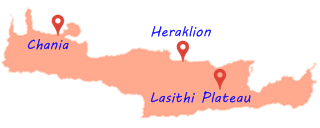
Lassithi Plateau, is a picturesque plain surrounded by mountains and is located in the prefecture of Lassithi, about 70km east of Heraklion.
It is the largest of all the plateaus of Crete and consists of a fertile and cultivable plain surrounded by the peaks of Mount Diktis.
Its area is 30 square kilometers and at its foot are built 18 beautiful villages. The inhabitants of the Plateau rely mainly on the agricultural and livestock economy, as the area produces many outdoor vegetables and fruits.
The main road that encloses the Lassithi Plateau, passes through most of the villages, in the main streets of which there are several tourist shops with traditional Cretan products, pottery, textiles but also small cafes and taverns with excellent food.
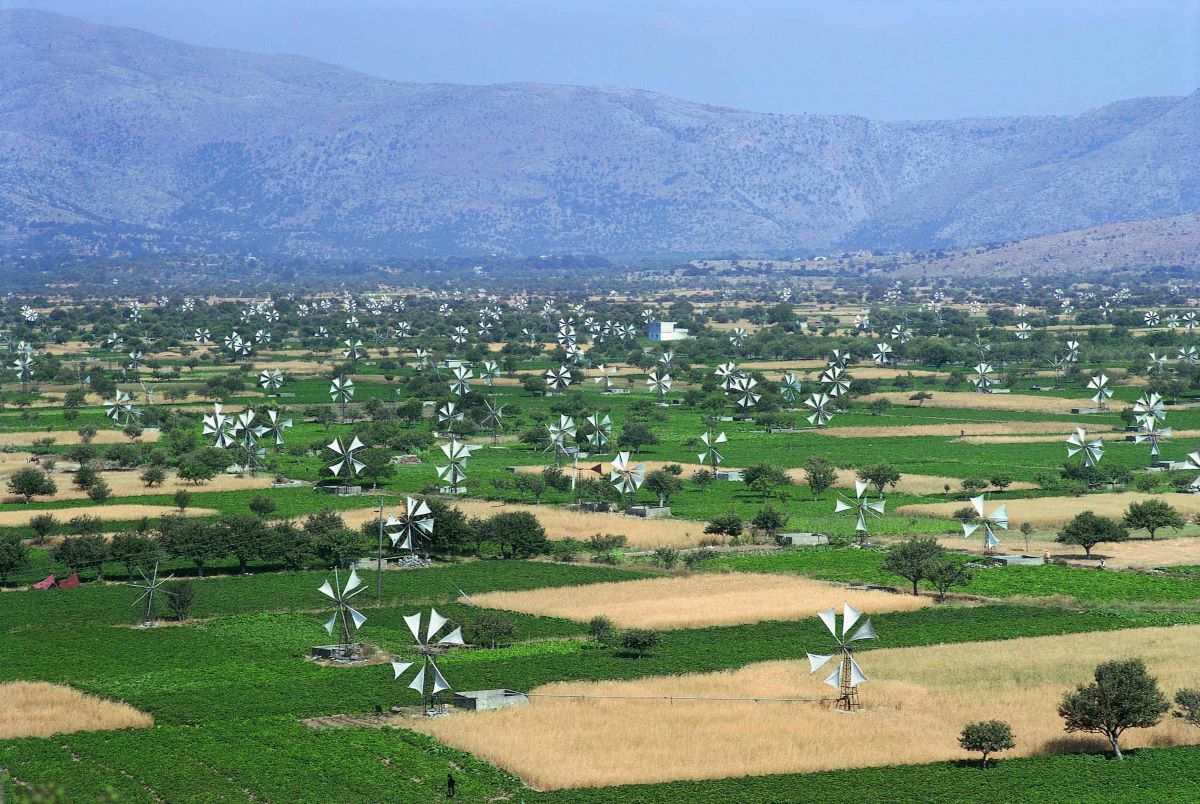
This beautiful circular route is ideal in spring and summer, as the road has no big uphills and along it you can visit all the sights of the Plateau. The Plateau during the winter months is covered with snow, the landscape is white offering a magnificent spectacle.
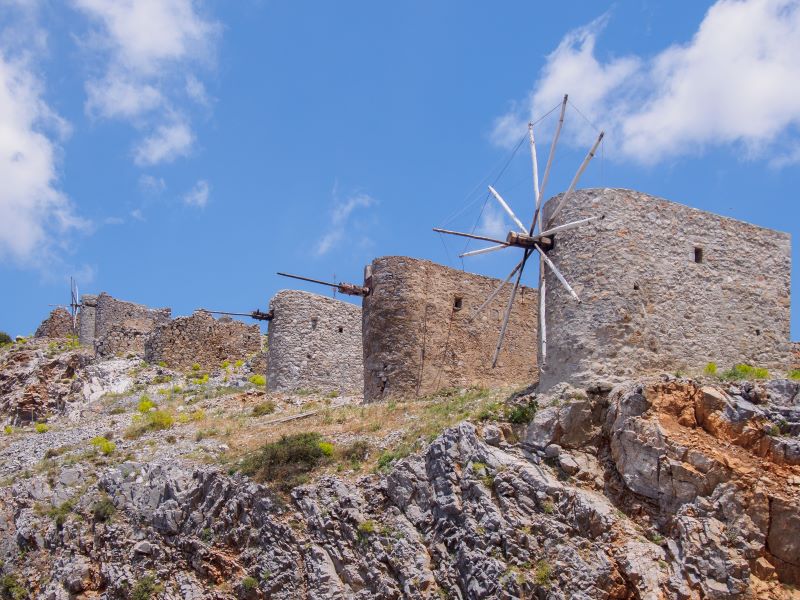 One of the most characteristic points of the plateau, are the 26 stone flour mills located in Seli Ampelou, at the main entrance of the plateau. Today, unfortunately, they are in ruins and only three of them have been rebuilt.
One of the most characteristic points of the plateau, are the 26 stone flour mills located in Seli Ampelou, at the main entrance of the plateau. Today, unfortunately, they are in ruins and only three of them have been rebuilt.
It is estimated that in the wider area of the plateau, at their peak, they reached about 5,000 and operated until 1950 when the latter stopped. These are windmills and watermills, most built in the late 19th century, for the purpose of water supply and irrigation of the Plateau.
Another special attraction of the Plateau is the linear drainage works made by the Venetians around 1463, the lines. These are sewers that were built to use the water from the surrounding mountains so as not to flood the plateau but also to irrigate the plain.
The plain of Lassithi Plateau, became the largest granary of the Venetian Empire under the name "Lascito olim Campagna di Lassiti".
The History of the Plateau
Lassithi Plateau, has been cultivated since the time of the Minoans and is considered to have been the last bastion of resistance of the Minoan Civilization against the Dorians. This magical place was soon connected with the most important event of Cretan mythology, namely the birth of Zeus, but also the capture of Minos from Europe.
Also, according to Greek mythology, the righteous King Minos received the orders of Zeus every nine years and made them laws for the people (the same myth is mentioned for the plateau of Nida in Psiloritis). When the cult of Zeus was transferred to the Idea Cave in Psiloritis, the Plateau began to lose its religious significance and was forgotten for many centuries.
Much later, when the Venetians occupied Crete, they banned its habitation, as this secluded place could feed the rebels. Thus, the Plateau was deserted until the Venetian settlers arrived in Crete from the Peloponnese and tried to give life to this barren place.
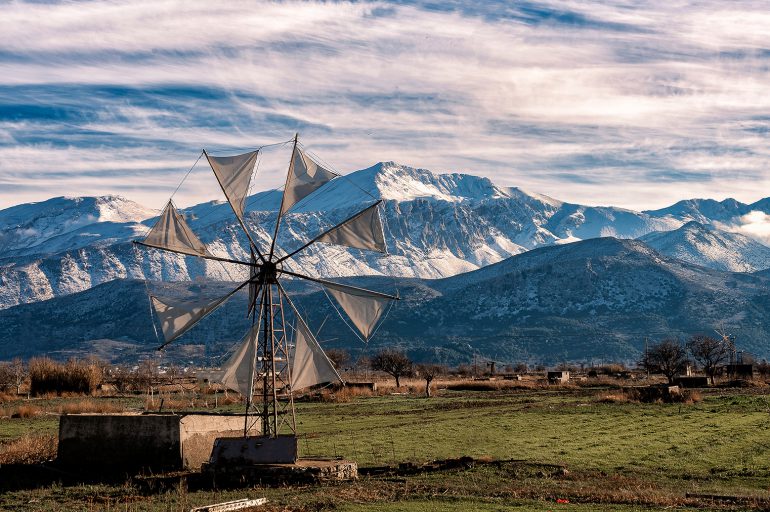
With a series of gigantic drainage works, the lines removed the stagnant waters of the plain, making the Plateau the most important place of cultivation in Crete. The lines, which are still visible today, divided the Plateau into 193 squares, which were given as lots to the new families. Because the lots in Venetian are called lassiti, for this reason they gave their name to the area.
During the Turkish occupation, the Plateau was an important place of resistance against the conquerors, as a result of which it became aware of their cruelty. The culmination is the Giant Battle of Lassithi, which took place in May 1867. After the holocaust of the Arkadi Monastery, the revolutionaries took refuge in Lassithi.
Thus, the Turkish-Egyptian army with 25,000 soldiers and led by the cruel Omer Pasha, ascended from the side of Kastelli, where it met the fierce resistance of the Cretans. However, the small number of Greek gunmen was not able to keep the Turks away, as a result of which they managed to enter the Plateau from the position "Tsouli Mnima". The rebels took refuge in the mountains and the unfortunate inhabitants of the Plateau were slaughtered, while their villages were completely destroyed for ten days.
During the Greek War of Independence in January 1823, Hassan Pasha led an army of Ottoman and Egyptian forces sent by Muhammad Ali that seized the plateau killing most residents who had not fled to the mountains. In May 1867 during the great Cretan revolt, Ottoman and Egyptian forces under the command of Pashas Omar and Ismail Selim marched towards the Lasithi plateau. Their aim was to strike a decisive blow on the revolutionaries who used it as their hideout. After fierce fighting, the outnumbered rebels were defeated and forced to retreat to the slopes of Dikti.
Between 21 and 29 of May, many village dwellers were slaughtered or taken slaves, their homes were set ablaze after being looted and livestock and crops were destroyed. The monastery of Kroustalenia that was the seat of the revolutionary committee was also destroyed.
Bank Cave or Cronio
The Bank Cave, also known as the Cronion Cave, is located on the borders of the settlement of Tzermiado, in Lassithi Plateau, at an altitude of 860m.
An uphill cobbled path with steps, tucked into prinos, leads to the cave after 5 'ascent. The entrance of the cave is indistinguishable and the view of the Plateau from its entrance is magnificent.
The cave has great archaeological value as it was used as a place of residence during the Neolithic and during the Early Minoan period. Later, when the Kastelos hill began to be systematically inhabited, and until the end of the Early Minoan III period, the cave was used as a burial place for the dead.
However, the archaeological excavation of 1936 brought to the surface findings of great archaeological value of the Neolithic, Early Minoan, Middle Minoan, Hellenistic and Byzantine eras.
The most important are the scarabs of the 11th Pharaonic dynasty, as well as an ivory figurine and others that show that relations had been developed with the countries of the Near East and especially with Egypt.
The Cronion was also used for worship purposes until it was replaced by the Dikteos. The Cronion consists of two rooms with development in niches. The entrance is narrow and a corridor with green sides from the humidity, leads to a small room.
In this room there are broken stalactites and stalagmites, damaged by human intervention. A large stalagmite in the middle of the cave leaves two passages on its sides. Also, small niches with columns protrude on the sides of the cave.
The wrinkled walls of the cave are a beautiful sight. To the right of the first plateau a cavity leads to a new room with a low ceiling. On one side the stalagmite in its natural form or properly shaped resembles a comfortable armchair.
Dikteon Andron - Cave of Zeus
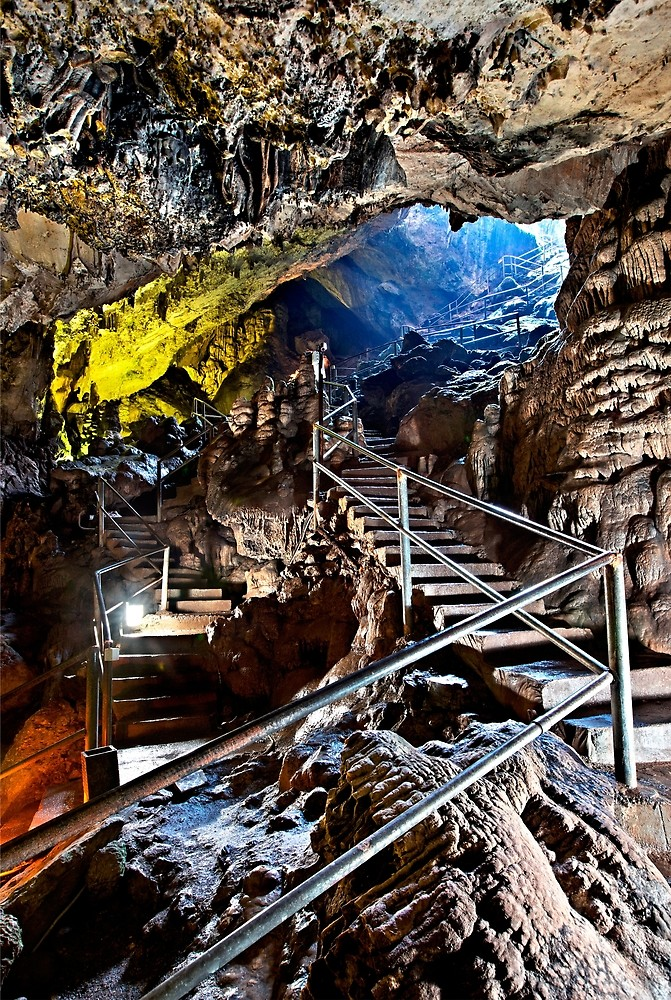 One of the most impressive caves of the island, is located at an altitude of 1025 meters, on the northern slopes of the Dikti mountain range, in the village of Psychro in the Lassithi Plateau. The cave of Psychros is the most important place of worship in Minoan Crete.
One of the most impressive caves of the island, is located at an altitude of 1025 meters, on the northern slopes of the Dikti mountain range, in the village of Psychro in the Lassithi Plateau. The cave of Psychros is the most important place of worship in Minoan Crete.
After all, the use of caves as centers of worship was one of the main features of the religious beliefs of the ancient Cretans. Believers arrived in the cave not only from nearby places, but also from very far away places, to honor the deity and to bring tributes. Stalactites and stalagmites that looked like idols became objects of worship.
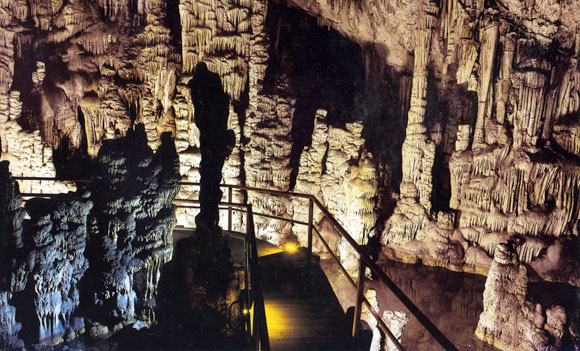
This sacred cave was identified with the famous Diktaion Andron, which according to ancient tradition, is the cave to which Rhea resorted to give birth to Zeus. The goat Amalthea, who according to another legend was a Nymph, raised Zeus, while the Kourites covered the cry of the baby with the sounds of their weapons and their wild dance.
According to other myths, the god was cared for by bees, pigeons or a female pig. According to another tradition, Diktaion Andron was the place where Zeus brought Europe, after he kidnapped it from Phenicia.
It was also said that Epimenides, the famous seer of the archaic period, slept in the cave for many years and had visions.
The cult probably dates back to the Early Minoan period (2800 - 2300 BC) - although there are traces of an older human presence in the vestibule at this point. However, the main findings are from the Middle Minoan period (1800 BC) and later, because its duration of use is long.
Its use continues uninterruptedly until the geometric (8th century BC) and eastern - archaic period (7th - 6th century BC).
From the findings it seems that the cave had visitors even during the Roman period. The faithful dedicated many votive offerings, such as figurines of believers, gods, animals, double axes, weapons, etc.
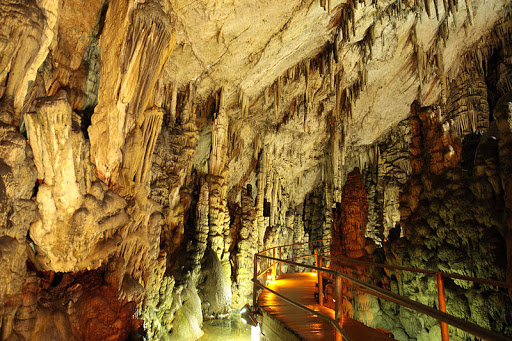
An uphill path leads to a plateau in front of the narrow entrance of the cave, which consists of two parts.
To the right opens a vestibule without stalagmite decoration, the so-called Upper Cave, in which there was a rectangular altar 1 meter high, built of mudstone. In this area, Neolithic shells, Early Minoan burials and votive offerings of the Middle Minoan period were also discovered.
The most important finds include clay figurines, sections of stone vessels, as well as small altars with inscriptions in Linear A writing. A low chamber develops in the northern part of the vestibule. In it was found an irregular enclosure with cobblestone floors in some places, which formed a kind of mosque.
In the Lower Cave, which is divided into five compartments, and where there is a small lake and huge stalagmite and stalactite formations, most of the tributes were revealed: animal figurines, bronze tools, knives, arrows, votive double axes, razors, blades sealstones, jewelry, bronze figurines, depicting men and women in worship poses, and bronze tiles, depicting young men carrying animals as offerings to the deity.
The large room of the lower cave is downhill, while in the background and on the left there is a small chamber, a recess of which was named as the "cradle" of Zeus. To the right is a larger chamber that is divided into two parts, in one of which there is a small lake, while in the other there is a particularly impressive stalactite, "the mantle of Zeus".
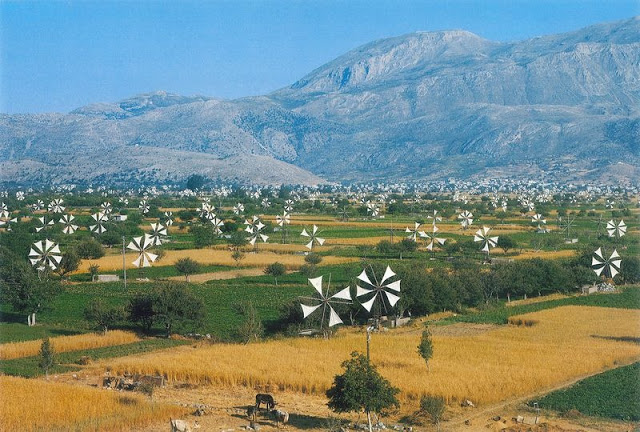


 One of the most characteristic points of the plateau, are the 26 stone flour mills located in Seli Ampelou, at the main entrance of the plateau. Today, unfortunately, they are in ruins and only three of them have been rebuilt.
One of the most characteristic points of the plateau, are the 26 stone flour mills located in Seli Ampelou, at the main entrance of the plateau. Today, unfortunately, they are in ruins and only three of them have been rebuilt. With a series of gigantic drainage works, the lines removed the stagnant waters of the plain, making the Plateau the most important place of cultivation in Crete. The lines, which are still visible today, divided the Plateau into 193 squares, which were given as lots to the new families. Because the lots in Venetian are called lassiti, for this reason they gave their name to the area.
With a series of gigantic drainage works, the lines removed the stagnant waters of the plain, making the Plateau the most important place of cultivation in Crete. The lines, which are still visible today, divided the Plateau into 193 squares, which were given as lots to the new families. Because the lots in Venetian are called lassiti, for this reason they gave their name to the area. One of the most impressive caves of the island, is located at an altitude of 1025 meters, on the northern slopes of the Dikti mountain range, in the village of Psychro in the Lassithi Plateau. The cave of Psychros is the most important place of worship in Minoan Crete.
One of the most impressive caves of the island, is located at an altitude of 1025 meters, on the northern slopes of the Dikti mountain range, in the village of Psychro in the Lassithi Plateau. The cave of Psychros is the most important place of worship in Minoan Crete. 
 An uphill path leads to a plateau in front of the narrow entrance of the cave, which consists of two parts.
An uphill path leads to a plateau in front of the narrow entrance of the cave, which consists of two parts.